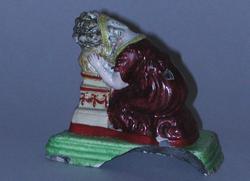Current Location: In storage
Titles
Kneeling woman
Maker(s)
Production:
Unidentified factory
Entities
Categories
Description
Earthenware figure, moulded, lead glazed and painted with red-brown, green, grey and yellow enamels.
Earthenware figure of a woman kneeling, with her head resting on a pillow atop a small plinth. Her arms clasp the pillar and her head is turned to the front; her eyes are closed and she is bare foot. She wears a red-brown dress, edged with yellow around the neck. Her elaborately styled hair is held in place by a band of yellow, raising to green at the front (possibly a crown??). The base is green, rectangular and raised with ridged sides. The figure is moulded and painted in the round. The underside of the base is recessed and glazed, with a small central vent hole.
Notes
History note: Bought at Graham’s in Brompton Road on 12 February 1912 for £1.5s (one pound five shillings) by Dr J.W.L. Glaisher, Trinity College, Cambridge.
Legal notes
Dr J. W. L. Glaisher Bequest, 1928
Measurements and weight
Depth: 5 cm
Height: 8.5 cm
Width: 9.5 cm
Acquisition and important dates
Method of acquisition: Bequeathed
(1928)
by
Glaisher, J. W. L., Dr
Dating
19th Century, Early
Circa
1810
-
1835
Note
Pearlware figures decorated with enamels were in production by 1780. They were generally made at smaller potteries and are rarely marked. A cheaper alternative to porcelain figures, they drew on a variety of 3-D sources, including sculpture and porcelain figures. Classical, biblical, mythological and literary subjects were popular, as were animals and representations of rural life, seasons and trades. From the early 19th Century, scenes from everyday life and topical events were also common. These early figures are moulded, perhaps with moulded or modelled parts added, the bases often formed separately. After around 1810-1820, bocage (stylised foliage) is common and figures are often more vibrantly coloured. By c.1835, these early methods had largely given way to three-part press-moulding, which enabled cheaper, mass production of figures for a growing market.
Components of the work
Decoration
composed of
enamels
lead-glaze
Materials used in production
White earthenware
Techniques used in production
Moulding
: Earthenware, moulded, lead glazed and painted with enamels.
Inscription or legends present
- Text: 3491. Staffordshire figure of a sleeping girl with her head on a pillow. Probably broken off from something else. b. in London Feb 12 1912.
- Location: Underside of base
- Method of creation: Rectangular paper label handwritten in black ink
- Type: Label
References and bibliographic entries
Identification numbers
Accession number: C.984-1928
Primary reference Number: 76494
Old object number: 3491
Stable URI
Audit data
Created: Saturday 6 August 2011
Updated: Monday 29 April 2024
Last processed: Tuesday 15 July 2025
Associated departments & institutions
Owner or interested party:
The Fitzwilliam Museum
Associated department:
Applied Arts





